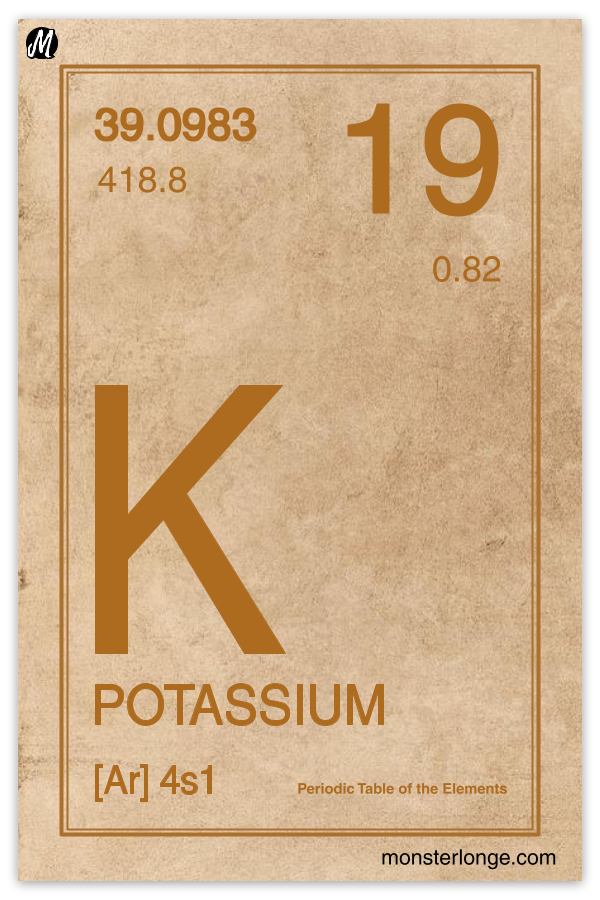
Potassium Food List
Potassium!
That’s right, you heard me.
The key to your problem is potassium!!!
If you’re like most Americans, you fall well short of the recommended daily intake of 4.7g of potassium per day, with that number being higher for those regularly engaged in intense physical activity for prolonged periods of time. And because you’re like most Americans who fall well short of the recommended daily intake of potassium, your muscles cramp while working out due to you losing what little potassium you do have through sweat.1Meeting potassium requirements is also important for reducing the risk of heart disease and stroke, as the mineral helps relax the walls of the blood vessels so blood can flow smoothly. Along that same front of lowering blood pressure, potassium also plays a role in filtering sodium in the kidneys for removal from the body. Additionally, potassium is essential for heart contractions, hormone regulation, calcium absorption, and the protection of bone density.2The recommended intake for potassium is 4700 mg. As stated, that comes out to 4.7 grams, as grams is a unit that people who aren’t drug dealers can more easily comprehend than milligrams. Most people don’t meet that goal and should do a better job of reaching or exceeding it, depending on their activity level.
Others, however, may be served not to increase their intake. One such example is people with kidney problems. If you’ve already been diagnosed with kidney issues, then you should consult with a medical professional to find out what your limit is to avoid potential nerve and muscle damage from the extra potassium staying in the body on account of the kidneys not working properly. Diabetics, people with a history of heart failure, and those who take high blood pressure medication are also prone to complications from hyperkalemia, or too much potassium. Seek medical advice if any of those conditions apply to you.
So yeah, the key to your problem is potassium!!!
SOURCES:
FRUITS
• Bananas
• Oranges
• Prunes
• Raisins
• Dates
• Apricots
• Grapefruit
• Honeydew
• Cantaloupe
• Watermelon
• Guava
• Papaya
• Avocados
• Tomatoes
• Cucumbers
• Zucchini
• Pumpkin
• Acorn Squash
• Butternut Squash
VEGETABLES
• Spinach
• Broccoli
• Kale
• Swiss Chard
• Beets
• Cabbage
• Bok Choy
• Peas
• Carrots
• Brussels Sprouts
• Mushrooms3Mushrooms are a fungus, not a vegetable. They’re listed as such here under their culinary classification rather than their botanical one.
TUBERS
• Potatoes
• Sweet Potatoes
• Yams
LEGUMES
• Black-Eyed Peas
• Pinto Beans
• Kidney Beans
• Adzuki Beans
• Navy Beans
• Great Northern Beans
• Lima Beans
• White Beans
• Black Beans
• Soybeans
• Nuts
PULSES
• Lentils
GRAINS
• Bran
• Wheat Germ
• Brown Rice
• White Rice
MEAT
• Chicken Breast
• Beef
• Pork
• Lamb
• Goat
• Venison
• Bison
SEAFOOD
• Clams
• Salmon
• Cod
• Rockfish
• Trout
• Halibut
• Tuna
• Sardines
• Tilapia
• Herring
• Haddock
• Catfish
• Seaweed
DAIRY
• Milk
• Soy Milk
• Almond Milk
• Yogurt
• Greek Yogurt
BEVERAGES
• Carrot Juice
• Tomato Juice
• Orange Juice
• Pomegranate Juice
• Apricot Juice
• Pineapple Juice
• Grapefruit Juice
• Coconut Water
MISCELLANEOUS
• Molasses
• Salt Substitutes4In salt substitutes, the sodium chloride in regular table salt is replaced with potassium chloride. The amount of potassium that’s replaced can range from 440 mg to 2800 mg per teaspoon depending on the product. Given this wide variation of potassium content in salt substitutes, it’s strongly advised to pay attention to the label to know how much potassium is provided by a product so you can limit the possibility of hyperkalemia. Also, you should consult with a doctor before using a salt substitute if you have kidney disease or are taking certain medications, such as ACE inhibitors, potassium-sparing diuretics, and angiotensin II receptor blockers (ARBs).
The foods in the list are some of the best sources of dietary potassium.
Get enough potassium from those foods and you should experience less frequent muscle cramping in the gym.5Other symptoms of low potassium that can be quickly alleviated by increasing intake include fatigue, weakness, tingling or numbness, constipation, and heart palpitations. In more severe cases, the symptoms extend to low blood pressure, lightheadedness or faintness, muscle paralysis, arrhythmia, and excessive thirst or urination.
If experiencing the latter effects of too little potassium, or hypokalemia, you may need to consult with a doctor who may then instruct you to raise your dietary potassium or prescribe a supplement. It’s only in that instance under a doctor’s supervision should you ever supplement with potassium to reduce the possibility of getting more than you need, which can impair the function of your kidneys and result in the symptoms of hyperkalemia, which include nausea and vomiting, chest pain, and diarrhea, as well as some of the symptoms of hypokalemia.
Now, as for what to do about your cramped apartment?
Hmmmmm…
Have you tried looking for a better job to make more money? What about moving to an area with a lower cost of living so you can buy more apartment for less money? And if the cramping has more to do with too many people living in a small space, have you tried telling your freeloading friends, family, or boy/girlfriend they have to contribute to the finances or get the fuck out?
Give all those suggestions a try!
Glossary: gym, hormones, muscle, supplement, work out
